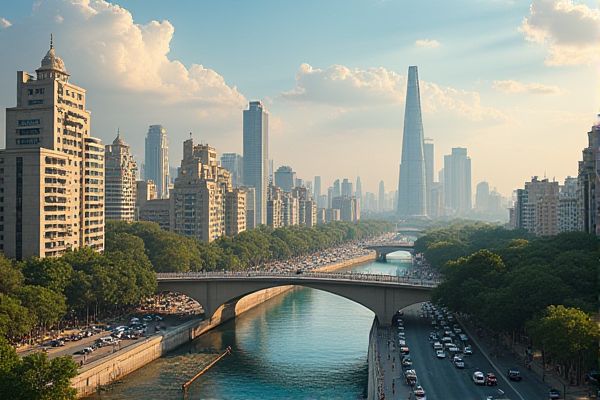
Healthcare facilities in India: Public and private sector options. Internationally accredited hospitals available. Availability of specialized treatments. India's medical tourism growth. Affordable healthcare services. Primary healthcare in rural areas. Health insurance options. English-speaking medical professionals. Popular for alternative medicine practices. Telemedicine services expanding rapidly.
Public and private sector options.
In India, the healthcare system is a multi-payer universal model, with public healthcare provided by the government being largely free or at a minimal cost, while private healthcare is predominantly for-profit and often expensive, accounting for a substantial portion of hospitals and doctors, particularly concentrated in urban areas. The public sector focuses on primary care and is widely available, but often lacks in quality and infrastructure, leading many to prefer private healthcare despite its higher costs. For more detailed insights into the structure and challenges of this system, visit the comprehensive resource on Healthcare in India.
Internationally accredited hospitals available.
India boasts 45 Joint Commission International (JCI) accredited hospitals, including notable institutions like Indraprastha Apollo Hospital in New Delhi, Fortis Memorial Research Institute in Gurugram, and Medanta The Medicity in Gurugram, ensuring high-quality healthcare services that meet international standards. These hospitals are recognized for their excellence in patient care, clinical skills, and advanced healthcare facilities. To explore more about these prestigious institutions, you can visit the Joint Commission International Accredited Hospitals in India and discover their commitment to maintaining superior healthcare benchmarks.
Availability of specialized treatments.
India offers a wide range of specialized treatments, including Cardiology, Orthopedic Surgeries, Cosmetic Surgery, Dental Care, Oncology, and Ophthalmology, as well as innovative therapies like Ayurvedic treatments, stem cell therapy, and minimally invasive surgeries. Many Indian hospitals are accredited by international organizations and are equipped with state-of-the-art facilities and technology, making them a hub for advanced medical treatments. For more information about these offerings, you can visit the Medical Tourism website.
India's medical tourism growth.
India's medical tourism has experienced remarkable growth of 33% in 2023 and is anticipated to exceed pre-pandemic levels in 2024, making it a significant contributor to the country's economy. This surge is largely driven by competitive treatment costs, world-class medical facilities, and supportive government initiatives, such as the introduction of e-Medical Visa Facilities for 167 countries. These factors collectively position India as an attractive destination for international patients seeking quality healthcare services.
Affordable healthcare services.
In India, affordable healthcare services are primarily provided through government facilities, which offer free outpatient and inpatient care, although these facilities often face challenges such as staff and supply shortages. The government's National Health Protection Scheme (Ayushman Bharat-PM-JAY) provides cashless secondary and tertiary care at private facilities for low-income families, and hospitals like Narayana Health and AIIMS offer high-quality care at affordable rates through innovative business models and government subsidies.
Primary healthcare in rural areas.
In rural India, primary healthcare is delivered through a tiered system of Sub-Centres, Primary Health Centres (PHCs), and Community Health Centres (CHCs). However, these facilities face significant challenges such as shortages of doctors, inadequate infrastructure, and a lack of trained workers, which often result in long travel distances for patients and a heavy reliance on private healthcare services. Efforts to improve this include Public-Private Partnerships and the use of telemedicine and advanced diagnostics. For more insights on this critical issue, you can read about it on Express Healthcare. Such initiatives aim to enhance both access and quality of care in these communities, addressing the pressing healthcare needs in rural regions.
Health insurance options.
In India, health insurance options include public schemes like the National Health Protection Scheme (Ayushman Bharat-Pradhan Mantri Jan Arogya Yojana) which covers secondary and tertiary care for low-income families, the Employees' State Insurance Scheme for workers, and private health insurance plans that cover hospitalizations. Various types such as individual, family floater, and critical illness plans are available, offering different levels of coverage to meet diverse needs. For deeper insights into these options and their impacts on healthcare accessibility, visit the International Health Policy Center.
English-speaking medical professionals.
India boasts a substantial English-speaking population, with many medical professionals fluent in English due to the country's education system, making them well-suited for roles such as virtual medical scribes and other healthcare positions that require clear communication. Additionally, Indian hospitals and medical staff, particularly in the context of medical tourism, are known for their proficiency in English, facilitating effective communication with international patients. For more insights into this evolving trend, visit the Rise of Virtual Medical Scribes page that discusses how this is a win-win solution for providers, enhancing healthcare accessibility and efficiency both domestically and internationally.
Popular for alternative medicine practices.
India is a hub for alternative medicine, particularly through its AYUSH system, which includes Ayurveda, Yoga, Naturopathy, Unani, Siddha, and Homeopathy. With strong government support, numerous educational and research institutions, and a significant portion of the population using these traditional medical systems, the industry continues to grow. For more insights into this flourishing sector, visit the India's Alternative Medicine Industry page. This growth has been particularly noticeable during the recent global health developments, where alternative and traditional practices offered complementary health solutions.
Telemedicine services expanding rapidly.
The India Telemedicine Market is expanding rapidly, driven by increased internet penetration, rising innovations in healthcare technology, and supportive government policies. With these positive factors in play, the market is expected to reach USD 15.2 billion by 2032, growing at a CAGR of 25.24% from 2024 to 2032. The advancements in telemedicine present significant opportunities for healthcare providers and patients alike, revolutionizing access to medical care across the region. For more comprehensive insights into these developments, visit the India Telemedicine Market.
